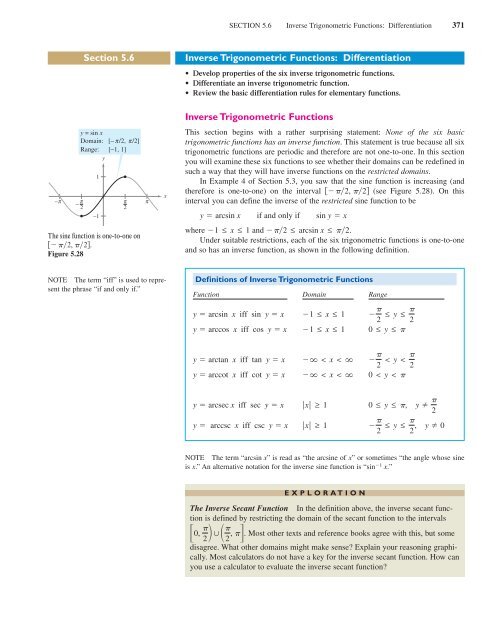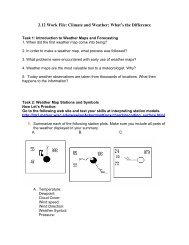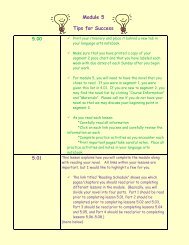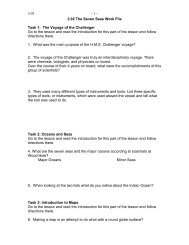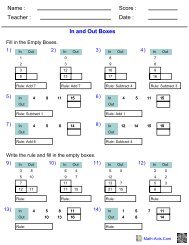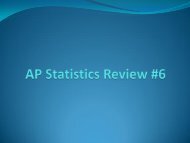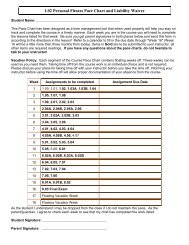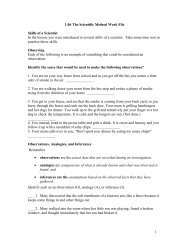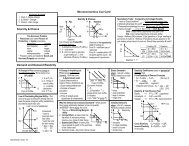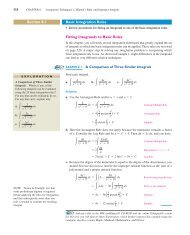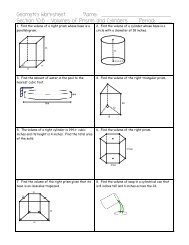Section 5.6 Inverse Trigonometric Functions: Differentiation Inverse ...
Section 5.6 Inverse Trigonometric Functions: Differentiation Inverse ...
Section 5.6 Inverse Trigonometric Functions: Differentiation Inverse ...
You also want an ePaper? Increase the reach of your titles
YUMPU automatically turns print PDFs into web optimized ePapers that Google loves.
332460_0506.qxd 11/1/04 4:01 PM Page 371<br />
SECTION <strong>5.6</strong> <strong>Inverse</strong> <strong>Trigonometric</strong> <strong>Functions</strong>: <strong>Differentiation</strong> 371<br />
<strong>Section</strong> <strong>5.6</strong><br />
<strong>Inverse</strong> <strong>Trigonometric</strong> <strong>Functions</strong>: <strong>Differentiation</strong><br />
• Develop properties of the six inverse trigonometric functions.<br />
• Differentiate an inverse trigonometric function.<br />
• Review the basic differentiation rules for elementary functions.<br />
<strong>Inverse</strong> <strong>Trigonometric</strong> <strong>Functions</strong><br />
−π<br />
y = sin x<br />
Domain: [ − π/2, π/2]<br />
Range: [ −1, 1]<br />
y<br />
1<br />
−<br />
π<br />
π<br />
2 2<br />
−1<br />
π<br />
x<br />
This section begins with a rather surprising statement: None of the six basic<br />
trigonometric functions has an inverse function. This statement is true because all six<br />
trigonometric functions are periodic and therefore are not one-to-one. In this section<br />
you will examine these six functions to see whether their domains can be redefined in<br />
such a way that they will have inverse functions on the restricted domains.<br />
In Example 4 of <strong>Section</strong> 5.3, you saw that the sine function is increasing (and<br />
therefore is one-to-one) on the interval 2, 2 (see Figure 5.28). On this<br />
interval you can define the inverse of the restricted sine function to be<br />
y arcsin x if and only if sin y x<br />
The sine function is one-to-one on<br />
2, 2.<br />
Figure 5.28<br />
where 1 ≤ x ≤ 1 and 2 ≤ arcsin x ≤ 2.<br />
Under suitable restrictions, each of the six trigonometric functions is one-to-one<br />
and so has an inverse function, as shown in the following definition.<br />
NOTE The term “iff” is used to represent<br />
the phrase “if and only if.”<br />
Definitions of <strong>Inverse</strong> <strong>Trigonometric</strong> <strong>Functions</strong><br />
Function<br />
Domain<br />
Range<br />
y arcsin x iff sin y x 1 ≤ x ≤ 1<br />
y arccos x iff cos y x 1 ≤ x ≤ 1<br />
<br />
<br />
<br />
<br />
2 ≤ y ≤ 2<br />
0 ≤ y ≤<br />
y arctan x iff tan y x<br />
<br />
2 < y < 2<br />
y arccot x iff cot y x < x < 0 < y <<br />
y arcsec x iff sec y x 0 ≤ y ≤ ,<br />
y<br />
y arccsc x iff csc y x<br />
< x < <br />
x ≥ 1<br />
x ≥ 1<br />
<br />
<br />
<br />
<br />
<br />
<br />
2 ≤ y ≤ 2 ,<br />
<br />
<br />
2<br />
y 0<br />
NOTE The term “arcsin x” is read as “the arcsine of x” or sometimes “the angle whose sine<br />
is x.” An alternative notation for the inverse sine function is “sin 1 x.”<br />
EXPLORATION<br />
The <strong>Inverse</strong> Secant Function In the definition above, the inverse secant function<br />
is defined by restricting the domain of the secant function to the intervals<br />
0,<br />
Most other texts and reference books agree with this, but some<br />
2 2 , .<br />
disagree. What other domains might make sense? Explain your reasoning graphically.<br />
Most calculators do not have a key for the inverse secant function. How can<br />
you use a calculator to evaluate the inverse secant function?
332460_0506.qxd 11/1/04 4:01 PM Page 372<br />
372 CHAPTER 5 Logarithmic, Exponential, and Other Transcendental <strong>Functions</strong><br />
The graphs of the six inverse trigonometric functions are shown in Figure 5.29.<br />
π<br />
2<br />
y<br />
y = arcsin x<br />
π<br />
y<br />
y = arccos x<br />
π<br />
2<br />
y<br />
y = arctan x<br />
−2 −1 1 2<br />
x<br />
π<br />
2<br />
−2 −1 1 2<br />
x<br />
π<br />
−<br />
2<br />
−2 −1 1 2<br />
x<br />
π<br />
−<br />
2<br />
Domain: 1, 1<br />
Range: 2, 2<br />
Domain: 1, 1<br />
Range: 0, <br />
Domain: , <br />
Range: 2, 2<br />
π<br />
2<br />
y<br />
y = arccsc x<br />
π<br />
y<br />
y = arcsec x<br />
π<br />
y<br />
y = arccot x<br />
−1 1 2<br />
x<br />
π<br />
2<br />
π<br />
2<br />
π<br />
−<br />
2<br />
−2 −1 1 2<br />
x<br />
−2 −1 1 2<br />
x<br />
Domain: , 1 1, <br />
Range: 2, 0 0, 2<br />
Figure 5.29<br />
Domain: , 1 1, <br />
Range: 0, 2 2, <br />
Domain: , <br />
Range: 0, <br />
EXAMPLE 1<br />
Evaluating <strong>Inverse</strong> <strong>Trigonometric</strong> <strong>Functions</strong><br />
Evaluate each function.<br />
a. b. arccos 0 c. arctan 3 d.<br />
arcsin 1 2<br />
arcsin0.3<br />
NOTE When evaluating inverse<br />
trigonometric functions, remember that<br />
they denote angles in radian measure.<br />
Solution<br />
a. By definition, y arcsin 1 2 implies that<br />
2, 2, the correct value of y is 6.<br />
sin y 1 2. In the interval<br />
arcsin 1 2 <br />
b. By definition, y arccos 0 implies that cos y 0. In the interval 0, , you have<br />
y 2.<br />
<br />
arccos 0 <br />
2<br />
c. By definition, y arctan 3 implies that tan y 3. In the interval<br />
2, 2, you have y 3.<br />
<br />
arctan 3 <br />
3<br />
<br />
d. Using a calculator set in radian mode produces<br />
arcsin0.3 0.305.<br />
6
332460_0506.qxd 11/1/04 4:01 PM Page 373<br />
SECTION <strong>5.6</strong> <strong>Inverse</strong> <strong>Trigonometric</strong> <strong>Functions</strong>: <strong>Differentiation</strong> 373<br />
EXPLORATION<br />
Graph y arccoscos x for<br />
≤ x ≤ 4. Why isn’t the graph<br />
the same as the graph of y x?<br />
4<br />
<strong>Inverse</strong> functions have the properties<br />
f f 1 x x and f 1 f x x.<br />
When applying these properties to inverse trigonometric functions, remember that the<br />
trigonometric functions have inverse functions only in restricted domains. For x-values<br />
outside these domains, these two properties do not hold. For example, arcsinsin is<br />
equal to 0, not .<br />
Properties of <strong>Inverse</strong> <strong>Trigonometric</strong> <strong>Functions</strong><br />
If 1 ≤ x ≤ 1 and 2 ≤ y ≤ 2, then<br />
sinarcsin x x and arcsinsin y y.<br />
If 2 < y < 2, then<br />
tanarctan x x and arctantan y y.<br />
If x ≥ 1 and 0 ≤ y < 2 or 2 < y ≤ , then<br />
secarcsec x x and arcsecsec y y.<br />
Similar properties hold for the other inverse trigonometric functions.<br />
EXAMPLE 2 Solving an Equation<br />
<br />
arctan2x 3 <br />
4<br />
tanarctan2x 3 tan<br />
4<br />
2x 3 1<br />
x 2<br />
<br />
Original equation<br />
Take tangent of each side.<br />
tanarctan x x<br />
Solve for x.<br />
1 x<br />
Some problems in calculus require that you evaluate expressions such as<br />
cosarcsin x, as shown in Example 3.<br />
y<br />
EXAMPLE 3<br />
Using Right Triangles<br />
y arcsin x<br />
Figure 5.30<br />
1 − x 2<br />
a. Given y arcsin x, where 0 < y < 2, find cos y.<br />
b. Given y arcsec52, find tan y.<br />
Solution<br />
y<br />
y arcsec 5<br />
2<br />
Figure 5.31<br />
5<br />
2<br />
1<br />
a. Because y arcsin x, you know that sin y x. This relationship between x and<br />
can be represented by a right triangle, as shown in Figure 5.30.<br />
y<br />
cos y cosarcsin x adj. 1 x2<br />
hyp.<br />
(This result is also valid for 2 < y < 0. )<br />
b. Use the right triangle shown in Figure 5.31.<br />
tan y tan arcsec 5<br />
2 opp.<br />
adj. 1 2
332460_0506.qxd 11/1/04 4:01 PM Page 374<br />
374 CHAPTER 5 Logarithmic, Exponential, and Other Transcendental <strong>Functions</strong><br />
NOTE There is no common agreement<br />
on the definition of arcsec x (or arccsc x)<br />
for negative values of x. When we<br />
defined the range of the arcsecant, we<br />
chose to preserve the reciprocal identity<br />
arcsec x arccos 1 x .<br />
For example, to evaluate arcsec2, you<br />
can write<br />
arcsec2 arccos0.5 2.09.<br />
One of the consequences of the definition<br />
of the inverse secant function given in<br />
this text is that its graph has a positive<br />
slope at every x-value in its domain.<br />
(See Figure 5.29.) This accounts for the<br />
absolute value sign in the formula for the<br />
derivative of arcsec x.<br />
Derivatives of <strong>Inverse</strong> <strong>Trigonometric</strong> <strong>Functions</strong><br />
In <strong>Section</strong> 5.1 you saw that the derivative of the transcendental function f x ln x<br />
is the algebraic function fx 1x. You will now see that the derivatives of<br />
the inverse trigonometric functions also are algebraic (even though the inverse<br />
trigonometric functions are themselves transcendental).<br />
The following theorem lists the derivatives of the six inverse trigonometric<br />
functions. Note that the derivatives of arccos u, arccot u, and arccsc u are the<br />
negatives of the derivatives of arcsin u, arctan u, and arcsec u, respectively.<br />
THEOREM 5.16 Derivatives of <strong>Inverse</strong> <strong>Trigonometric</strong> <strong>Functions</strong><br />
Let u be a differentiable function of x.<br />
d<br />
u<br />
arccos u <br />
dx arcsin u u<br />
1 u 2 dx 1 u 2<br />
d<br />
u<br />
arctan u <br />
dx<br />
1 u 2 d<br />
d<br />
dx arcsec u u<br />
u u2 1<br />
d<br />
u<br />
arccot u <br />
dx 1 u 2<br />
d<br />
dx arccsc u u<br />
u u2 1<br />
To derive these formulas, you can use implicit differentiation. For instance, if<br />
y arcsin x, then sin y x and cos yy 1. (See Exercise 94.)<br />
TECHNOLOGY If your<br />
graphing utility does not have the<br />
arcsecant function, you can obtain its<br />
graph using<br />
f x arcsec x arccos 1 x .<br />
EXAMPLE 4<br />
a.<br />
b.<br />
c.<br />
d.<br />
d<br />
dx arcsec e2x <br />
Differentiating <strong>Inverse</strong> <strong>Trigonometric</strong> <strong>Functions</strong><br />
d<br />
dx arcsin2x 2<br />
1 2x 2<br />
2 1 4x 2<br />
d<br />
dx arctan3x 3<br />
1 3x 3<br />
2 1 9x 2<br />
d<br />
12 x12<br />
arcsin x <br />
dx 1 x<br />
2e 2x<br />
e 2x e 2x 2 1 <br />
1<br />
2x1 x 1<br />
2x x 2<br />
2e 2x<br />
e 2x e 4x 1 2<br />
e 4x 1<br />
The absolute value sign is not necessary because e 2x > 0.<br />
EXAMPLE 5<br />
A Derivative That Can Be Simplified<br />
NOTE From Example 5, you can see<br />
one of the benefits of inverse trigonometric<br />
functions—they can be used to<br />
integrate common algebraic functions.<br />
For instance, from the result shown in<br />
the example, it follows that<br />
1 x 2 dx<br />
1 2 arcsin x x1 x2 .<br />
Differentiate y arcsin x x1 x 2 .<br />
Solution<br />
y <br />
<br />
1<br />
1 x 2 x 1 2 2x1 x2 12 1 x 2<br />
1<br />
1 x x 2<br />
1 2 x2<br />
1 x2 1 x 2 1 x 2<br />
21 x 2
332460_0506.qxd 11/1/04 4:01 PM Page 375<br />
SECTION <strong>5.6</strong> <strong>Inverse</strong> <strong>Trigonometric</strong> <strong>Functions</strong>: <strong>Differentiation</strong> 375<br />
EXAMPLE 6<br />
Analyzing an <strong>Inverse</strong> <strong>Trigonometric</strong> Graph<br />
Analyze the graph of y arctan x 2 .<br />
3 y = π 2<br />
4<br />
y = (arctan x) 2 2<br />
−2<br />
−1<br />
1<br />
−1<br />
y<br />
Points of<br />
inflection<br />
The graph of y arctan x 2 has a horizontal<br />
asymptote at y <br />
Figure 5.32<br />
1<br />
2<br />
4.<br />
2<br />
x<br />
Solution<br />
From the derivative<br />
y 2arctan x <br />
1<br />
you can see that the only critical number is x 0. By the First Derivative Test, this<br />
value corresponds to a relative minimum. From the second derivative<br />
1 x 2 <br />
2<br />
1 x2 2 arctan x2x<br />
1 x 2 2<br />
y <br />
2 arctan x<br />
1 x 2<br />
<br />
21 2x arctan x<br />
1 x 2 2<br />
it follows that points of inflection occur when 2x arctan x 1. Using Newton’s<br />
Method, these points occur when x ±0.765. Finally, because<br />
lim arctan<br />
x→± x2 <br />
1 x 2<br />
<br />
2<br />
4<br />
it follows that the graph has a horizontal asymptote at y 2<br />
4. The graph is shown<br />
in Figure 5.32.<br />
EXAMPLE 7<br />
Maximizing an Angle<br />
A photographer is taking a picture of a four-foot painting hung in an art gallery. The<br />
camera lens is 1 foot below the lower edge of the painting, as shown in Figure 5.33.<br />
How far should the camera be from the painting to maximize the angle subtended by<br />
the camera lens?<br />
Solution In Figure 5.33, let be the angle to be maximized.<br />
<br />
arccot x 5 arccot x<br />
<br />
4 ft<br />
1 ft<br />
α β θ<br />
x<br />
Not drawn to scale<br />
The camera should be 2.236 feet from the<br />
painting to maximize the angle .<br />
Figure 5.33<br />
Differentiating produces<br />
d<br />
dx <br />
<br />
<br />
15<br />
1 x 2 25 1<br />
1 x 2<br />
5<br />
25 x 1<br />
2 1 x 2<br />
45 x 2 <br />
25 x 2 1 x 2 .<br />
Because ddx 0 when x 5, you can conclude from the First Derivative Test<br />
that this distance yields a maximum value of . So, the distance is x 2.236 feet and<br />
the angle is<br />
radian 41.81.<br />
0.7297
332460_0506.qxd 11/1/04 4:01 PM Page 376<br />
376 CHAPTER 5 Logarithmic, Exponential, and Other Transcendental <strong>Functions</strong><br />
The Granger Collection<br />
GALILEO GALILEI (1564–1642)<br />
Galileo’s approach to science departed from<br />
the accepted Aristotelian view that nature had<br />
describable qualities, such as “fluidity”and<br />
“potentiality.”He chose to describe the physical<br />
world in terms of measurable quantities,<br />
such as time, distance, force, and mass.<br />
Review of Basic <strong>Differentiation</strong> Rules<br />
In the 1600s, Europe was ushered into the scientific age by such great thinkers as<br />
Descartes, Galileo, Huygens, Newton, and Kepler. These men believed that nature is<br />
governed by basic laws—laws that can, for the most part, be written in terms of<br />
mathematical equations. One of the most influential publications of this period—<br />
Dialogue on the Great World Systems, by Galileo Galilei—has become a classic<br />
description of modern scientific thought.<br />
As mathematics has developed during the past few hundred years, a small number<br />
of elementary functions has proven sufficient for modeling most* phenomena in<br />
physics, chemistry, biology, engineering, economics, and a variety of other fields. An<br />
elementary function is a function from the following list or one that can be formed<br />
as the sum, product, quotient, or composition of functions in the list.<br />
Algebraic <strong>Functions</strong><br />
Polynomial functions<br />
Rational functions<br />
<strong>Functions</strong> involving radicals<br />
Transcendental <strong>Functions</strong><br />
Logarithmic functions<br />
Exponential functions<br />
<strong>Trigonometric</strong> functions<br />
<strong>Inverse</strong> trigonometric functions<br />
With the differentiation rules introduced so far in the text, you can differentiate any<br />
elementary function. For convenience, these differentiation rules are summarized<br />
below.<br />
Basic <strong>Differentiation</strong> Rules for Elementary <strong>Functions</strong><br />
d<br />
d<br />
1. cu cu<br />
2. u ± v u ± v<br />
3.<br />
dx dx<br />
d<br />
d<br />
4. 5. 6.<br />
dx u v vu uv<br />
v dx c 0<br />
2<br />
d<br />
d<br />
7. 8. 9.<br />
dx u <br />
u u u, u 0<br />
dx x 1<br />
d<br />
d<br />
10. 11. 12.<br />
dx log u<br />
a u <br />
dx eu e u u<br />
ln au<br />
d<br />
d<br />
13. sin u cos uu<br />
14. cos u sin uu<br />
15.<br />
dx dx<br />
d<br />
d<br />
16. 17. sec u sec u tan uu 18.<br />
dx cot u csc2 uu<br />
dx<br />
d<br />
d<br />
u<br />
d<br />
19. 20. arccos u 21.<br />
dx arcsin u u<br />
1 u 2<br />
dx 1 u 2<br />
d<br />
u<br />
d<br />
22. 23. 24.<br />
dx arcsec u u<br />
arccot u <br />
dx 1 u 2<br />
u u2 1<br />
d<br />
dx uv uv vu<br />
d<br />
dx un nu n1 u<br />
d u<br />
ln u <br />
dx u<br />
d<br />
dx au ln aa u u<br />
d<br />
dx tan u sec2 uu<br />
d<br />
csc u csc u cot uu<br />
dx<br />
u<br />
arctan u <br />
dx 1 u 2<br />
d<br />
dx arccsc u u<br />
u u2 1<br />
* Some important functions used in engineering and science (such as Bessel functions and<br />
gamma functions) are not elementary functions.
332460_0506.qxd 11/1/04 4:01 PM Page 377<br />
SECTION <strong>5.6</strong> <strong>Inverse</strong> <strong>Trigonometric</strong> <strong>Functions</strong>: <strong>Differentiation</strong> 377<br />
Exercises for <strong>Section</strong> <strong>5.6</strong><br />
Numerical and Graphical Analysis In Exercises 1 and 2,<br />
(a) use a graphing utility to complete the table, (b) plot the<br />
points in the table and graph the function by hand, (c) use a<br />
graphing utility to graph the function and compare the result<br />
with your hand-drawn graph in part (b), and (d) determine any<br />
intercepts and symmetry of the graph.<br />
x<br />
y<br />
1<br />
3. Determine the missing coordinates of the points on the graph of<br />
the function.<br />
(<br />
0.8<br />
y = arccos x<br />
,<br />
3π<br />
4<br />
)<br />
0.6<br />
π<br />
1<br />
,<br />
2<br />
−1 1<br />
0<br />
4. Determine the missing coordinates of the points on the graph of<br />
the function.<br />
π<br />
2<br />
,<br />
π<br />
4<br />
−3 3<br />
π<br />
( , −<br />
6)<br />
π<br />
− 2<br />
(<br />
(<br />
0.4<br />
In Exercises 5–12, evaluate the expression without using a<br />
calculator.<br />
5. arcsin 1 2<br />
6. arcsin 0<br />
7. arccos 1 2<br />
8. arccos 0<br />
9. arctan 3<br />
3<br />
10. arccot3 <br />
11. arccsc2<br />
12.<br />
arccos 3<br />
2 <br />
In Exercises 13–16, use a calculator to approximate the value.<br />
Round your answer to two decimal places.<br />
13. arccos0.8<br />
14. arcsin0.39<br />
15. arcsec 1.269<br />
16. arctan3<br />
(<br />
)<br />
y = arctan x<br />
− 3 ,<br />
)<br />
)<br />
0.2<br />
1. y arcsin x<br />
2. y arccos x<br />
3<br />
( ,<br />
2 )<br />
0 0.2 0.4 0.6 0.8 1<br />
In Exercises 17–20, evaluate each expression without using a<br />
calculator. (Hint: See Example 3.)<br />
17. (a) 18. (a)<br />
(b)<br />
19. (a) 20. (a)<br />
(b)<br />
(b) cos arcsin<br />
13<br />
5<br />
In Exercises 21–28, write the expression in algebraic form.<br />
(b)<br />
21. cosarcsin 2x<br />
22. secarctan 4x<br />
23. sinarcsec x<br />
24. cosarccot x<br />
25. 26. secarcsinx 1<br />
27. csc <br />
x<br />
arctan<br />
28.<br />
In Exercises 29 and 30, (a) use a graphing utility to graph f and<br />
g in the same viewing window to verify that they are equal, (b)<br />
use algebra to verify that f and g are equal, and (c) identify any<br />
horizontal asymptotes of the graphs.<br />
29.<br />
30.<br />
In Exercises 31–34, solve the equation for x.<br />
31. arcsin3x ) 1 2 32. arctan2x 5 1<br />
33. arcsin2x arccosx 34. arccos x arcsec x<br />
In Exercises 35 and 36, verify each identity.<br />
35. (a)<br />
See www.CalcChat.com for worked-out solutions to odd-numbered exercises.<br />
sin arctan 3 4<br />
sec arcsin 4 5<br />
cot arcsin 1 2<br />
csc arctan 5<br />
12<br />
tan arcsec x 3<br />
2<br />
f x sinarctan 2x,<br />
f x tan arccos x 2 ,<br />
g x <br />
arccsc x arcsin 1 x , x ≥ 1<br />
4 x2<br />
g x <br />
x<br />
(b) arctan x arctan 1 x 2 , x > 0<br />
36. (a)<br />
(b)<br />
arcsinx arcsin x, x ≤ 1<br />
arccosx arccos x, x ≤ 1<br />
In Exercises 37–40, sketch the graph of the function. Use a<br />
graphing utility to verify your graph.<br />
37. f x arcsinx 1 38. f x arctan x <br />
2<br />
39. f x arcsec 2x<br />
40. f x arccos x 4<br />
<br />
tan arccos 2<br />
2 <br />
sec arctan 3 5<br />
tan arcsin 5 6<br />
cos arcsin x h<br />
r <br />
2x<br />
1 4x 2
332460_0506.qxd 11/1/04 4:01 PM Page 378<br />
378 CHAPTER 5 Logarithmic, Exponential, and Other Transcendental <strong>Functions</strong><br />
In Exercises 41–60, find the derivative of the function.<br />
41. f x 2 arcsinx 1 42. f t arcsin t 2<br />
43. gx 3 arccos x 44. f x arcsec 2x<br />
2<br />
65. y 4x arccosx 1 66.<br />
y<br />
y = 4x arccos (x − 1)<br />
(1, 2 π)<br />
2π<br />
y 3x arcsin x<br />
y<br />
y = 3x arcsin x<br />
2π<br />
45. f x arctan x 46. f x arctanx<br />
a<br />
arcsin 3x<br />
47. gx 48. hx x 2 arctan x<br />
x<br />
49. ht sinarccos t 50. f x arcsin x arccos x<br />
51. y x arccos x 1 x 52. y lnt 2 4 1 2 arctan t 2<br />
2<br />
53.<br />
54.<br />
55.<br />
56.<br />
y 1 2 1 2 ln x 1<br />
x 1 arctan x <br />
y <br />
2 1 x4 x2 4 arcsin <br />
x<br />
2<br />
y x arcsin x 1 x 2<br />
y x arctan 2x 1 4 ln1 4x2 <br />
π<br />
x<br />
1 2<br />
( , )<br />
π<br />
1 π<br />
2 4<br />
x<br />
−1<br />
1<br />
Linear and Quadratic Approximations In Exercises 67–70, use<br />
a computer algebra system to find the linear approximation<br />
P 1 x f a fax a<br />
and the quadratic approximation<br />
P 2 x f a fa)x a 1 2 fax a 2<br />
of the function f at x a. Sketch the graph of the function and<br />
its linear and quadratic approximations.<br />
57.<br />
y 8 arcsin x 4<br />
<br />
x16 x2<br />
2<br />
67. f x arctan x, a 0 68.<br />
69. f x arcsin x, a 1 2 70.<br />
f x arccos x,<br />
f x arctan x,<br />
a 0<br />
a 1<br />
58.<br />
59.<br />
60.<br />
y 25 arcsin x x25 x2<br />
5<br />
y arctan x <br />
In Exercises 61–66, find an equation of the tangent line to the<br />
graph of the function at the given point.<br />
−1<br />
63. y arctan x 64. y arcsec 4x<br />
2<br />
−4<br />
−2<br />
π<br />
π<br />
2<br />
−<br />
π<br />
2<br />
−π<br />
π<br />
2<br />
π<br />
4<br />
−<br />
π<br />
2<br />
y<br />
y<br />
y = 2 arcsin x<br />
1<br />
2<br />
x<br />
1 x 2<br />
y arctan x 2 1<br />
2x 2 4<br />
61. y 2 arcsin x<br />
62. y 1 2 arccos x<br />
x<br />
y = arctan<br />
2<br />
2<br />
1<br />
( , π)<br />
2 3<br />
x<br />
1<br />
( 2, π)<br />
4<br />
4<br />
x<br />
)<br />
2 π<br />
−<br />
3<br />
2<br />
,<br />
8 )<br />
−1<br />
y = arcsec 4x<br />
−1<br />
−<br />
1<br />
2<br />
π<br />
2<br />
−<br />
1<br />
2<br />
y<br />
π<br />
2<br />
π<br />
4<br />
1<br />
y = arccos x<br />
2<br />
y<br />
1<br />
2<br />
2 π<br />
( , )<br />
4<br />
1<br />
2<br />
1<br />
4<br />
1<br />
x<br />
x<br />
In Exercises 71–74, find any relative extrema of the function.<br />
71. f x arcsec x x<br />
72. f x arcsin x 2x<br />
73. f x arctan x arctanx 4<br />
74. hx arcsin x 2 arctan x<br />
Implicit <strong>Differentiation</strong> In Exercises 75–78, find an equation of<br />
the tangent line to the graph of the equation at the given point.<br />
75. x 4 , 1 <br />
2 x arctan y y 1,<br />
76. arctanxy arcsinx y, 0, 0<br />
77. arcsin x arcsin y 2<br />
2 , 2<br />
2 , 2 <br />
78. arctanx y y 2 1, 0<br />
4 ,<br />
Writing About Concepts<br />
<br />
<br />
79. Explain why the domains of the trigonometric functions are<br />
restricted when finding the inverse trigonometric functions.<br />
80. Explain why tan 0 does not imply that arctan 0 .<br />
81. Explain how to graph y arccot x on a graphing utility<br />
that does not have the arccotangent function.<br />
82. Are the derivatives of the inverse trigonometric functions<br />
algebraic or transcendental functions? List the derivatives<br />
of the inverse trigonometric functions.
332460_0506.qxd 11/1/04 4:01 PM Page 379<br />
SECTION <strong>5.6</strong> <strong>Inverse</strong> <strong>Trigonometric</strong> <strong>Functions</strong>: <strong>Differentiation</strong> 379<br />
True or False? In Exercises 83–88, determine whether the<br />
statement is true or false. If it is false, explain why or give an<br />
example that shows it is false.<br />
83. Because cos it follows that arccos<br />
3 1 1 2 ,<br />
2 3 .<br />
84. arcsin<br />
4 2<br />
2<br />
85. The slope of the graph of the inverse tangent function is<br />
positive for all x.<br />
86. The range of y arcsin x is 0, .<br />
d<br />
87. for all x in the domain.<br />
dx arctantan x 1<br />
88. arcsin 2 x arccos 2 x 1<br />
<br />
89. Angular Rate of Change An airplane flies at an altitude of 5<br />
miles toward a point directly over an observer. Consider and<br />
x as shown in the figure.<br />
(a) Write as a function of x.<br />
(b) The speed of the plane is 400 miles per hour. Find ddt<br />
when x 10 miles and x 3 miles.<br />
<br />
θ<br />
<br />
x<br />
90. Writing Repeat Exercise 89 if the altitude of the plane is 3<br />
miles and describe how the altitude affects the rate of change<br />
of .<br />
91. Angular Rate of Change In a free-fall experiment, an object<br />
is dropped from a height of 256 feet. A camera on the ground<br />
500 feet from the point of impact records the fall of the object<br />
(see figure).<br />
(a) Find the position function giving the height of the object at<br />
time t assuming the object is released at time t 0. At what<br />
time will the object reach ground level?<br />
(b) Find the rates of change of the angle of elevation of the<br />
camera when t 1 and t 2.<br />
<br />
5 mi<br />
Not drawn to scale<br />
<br />
92. Angular Rate of Change A television camera at ground<br />
level is filming the lift-off of a space shuttle at a point 750<br />
meters from the launch pad. Let be the angle of elevation of<br />
the shuttle and let s be the distance between the camera and<br />
the shuttle (see figure). Write as a function of s for the period<br />
of time when the shuttle is moving vertically. Differentiate<br />
the result to find ddt in terms of s and<br />
93. (a) Prove that<br />
arctan x arctan y arctan x y xy 1.<br />
(b) Use the formula in part (a) to show that<br />
arctan 1 2 arctan 1 3 4 .<br />
94. Verify each differentiation formula.<br />
(a)<br />
(c)<br />
(d)<br />
d<br />
(f)<br />
dx arccsc u u<br />
u u2 1<br />
95. Existence of an <strong>Inverse</strong> Determine the values of k such that<br />
the function f x kx sin x has an inverse function.<br />
96. Think About It Use a graphing utility to graph f x sin x<br />
and gx arcsinsin x.<br />
(a) Why isn’t the graph of g the line y x?<br />
(b) Determine the extrema of g.<br />
97. (a) Graph the function f x arccos x arcsin x on the<br />
interval 1, 1. (b) Describe the graph of f. (c) Prove the<br />
result from part (b) analytically.<br />
98. Prove that arcsin x arctan x<br />
1 x 2, x < 1.<br />
99. Find the value of c in the interval 0, 4 on the x-axis that<br />
maximizes angle .<br />
y<br />
d<br />
dx arcsin u u<br />
1 u 2<br />
d<br />
dx arcsec u u<br />
d<br />
u<br />
arccos u <br />
dx 1 u 2<br />
(0, 2) (4, 2)<br />
<br />
u u2 1<br />
3<br />
<br />
Q<br />
R<br />
<br />
1 xy , dsdt.<br />
(b)<br />
(e)<br />
θ<br />
d<br />
u<br />
arccot u <br />
dx 1 u 2<br />
2<br />
d<br />
u<br />
arctan u <br />
dx 1 u 2<br />
256 ft<br />
s<br />
θ<br />
θ<br />
500 ft<br />
750 m<br />
Figure for 91 Figure for 92<br />
h<br />
θ<br />
c<br />
Figure for 99 Figure for 100<br />
100. Find PR such that 0 ≤ PR ≤ 3 and m is a maximum.<br />
101. Some calculus textbooks define the inverse secant function<br />
using the range 0, 2 , 32.<br />
(a) Sketch the graph y arcsec x using this range.<br />
(b) Show that y <br />
x<br />
P<br />
1<br />
xx 2 1 .<br />
5


